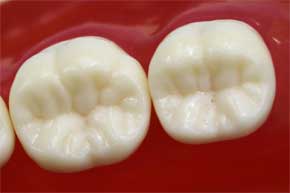①Five cusps
More than 90% of Japanese individuals exhibit a five-cusp morphology on the mandibular first molars.
②Deflected ridge
This ridge originates from the mesiolingual cusp of the mandibular first molar and bends distally as it approaches the central groove, forming a characteristic angulation.
③Dryopithecus pattern
Various morphological variations are observed in the groove pattern of mandibular molars, particularly at the intersection of the longitudinal and transverse grooves. These patterns are generally classified into two main types: the Y-shaped (Dryopithecus pattern) and the '+'-shaped (cruciform) pattern."
④Four cusps
Among Japanese individuals, the most common cusp pattern of the mandibular second molar is the '+'-shaped four-cusp type, followed by the '+'-shaped five-cusp type.
⑤The grooves form a cruciform (+-shaped) pattern. In over 90% of Japanese individuals, the mandibular second molar displays this characteristic cruciform groove morphology.
|
